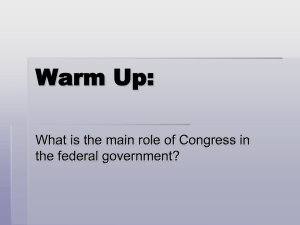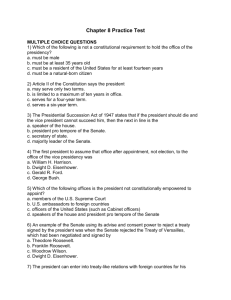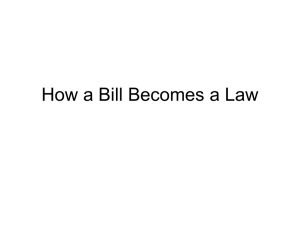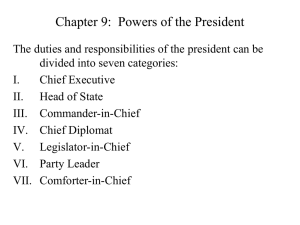Classroom Lawmaking Activity
advertisement
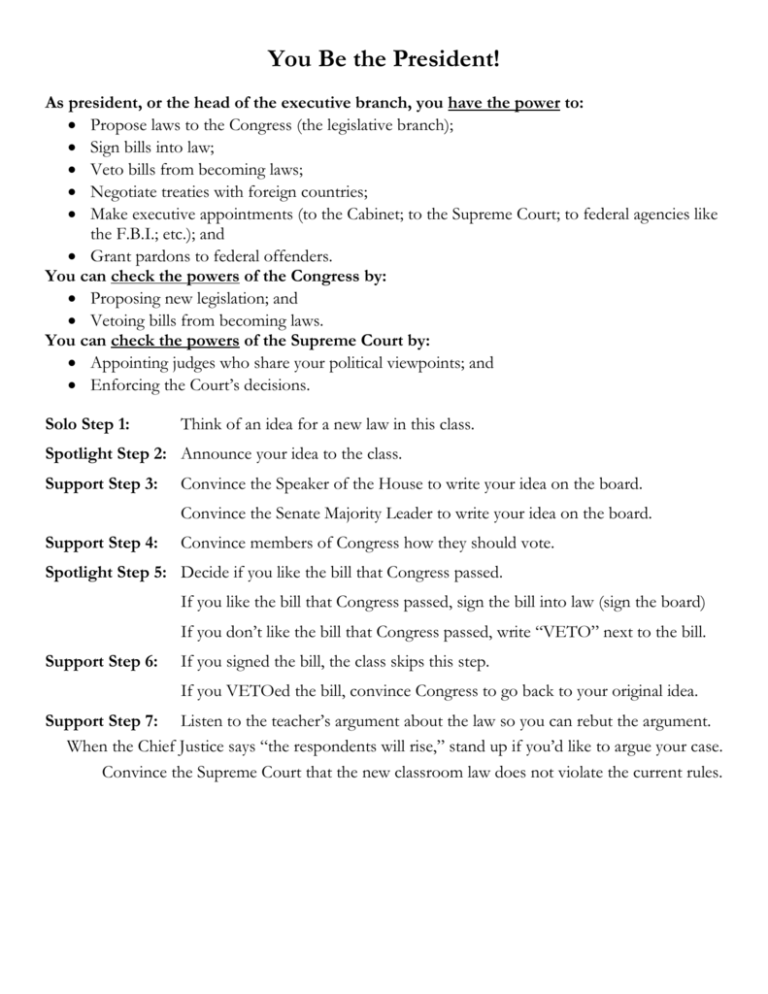
You Be the President! As president, or the head of the executive branch, you have the power to: Propose laws to the Congress (the legislative branch); Sign bills into law; Veto bills from becoming laws; Negotiate treaties with foreign countries; Make executive appointments (to the Cabinet; to the Supreme Court; to federal agencies like the F.B.I.; etc.); and Grant pardons to federal offenders. You can check the powers of the Congress by: Proposing new legislation; and Vetoing bills from becoming laws. You can check the powers of the Supreme Court by: Appointing judges who share your political viewpoints; and Enforcing the Court’s decisions. Solo Step 1: Think of an idea for a new law in this class. Spotlight Step 2: Announce your idea to the class. Support Step 3: Convince the Speaker of the House to write your idea on the board. Convince the Senate Majority Leader to write your idea on the board. Support Step 4: Convince members of Congress how they should vote. Spotlight Step 5: Decide if you like the bill that Congress passed. If you like the bill that Congress passed, sign the bill into law (sign the board) If you don’t like the bill that Congress passed, write “VETO” next to the bill. Support Step 6: If you signed the bill, the class skips this step. If you VETOed the bill, convince Congress to go back to your original idea. Support Step 7: Listen to the teacher’s argument about the law so you can rebut the argument. When the Chief Justice says “the respondents will rise,” stand up if you’d like to argue your case. Convince the Supreme Court that the new classroom law does not violate the current rules. You Be the House of Representatives! As a member of the House of Representatives in the legislative branch, you have the power to: Introduce new laws; Override a presidential veto; Coin money; Borrow money on behalf of the United States; Appropriate money to the executive branch; Declare war; and Impeach or remove the president. You can check the powers of the president by: Overriding a presidential veto on a bill; Impeaching or removing the president; You can check the powers of the Supreme Court by: Confirming judiciary appointments to the Court; Impeaching or removing justices; and Proposing new amendments to the Constitution. Solo Step 1: Vote on a Speaker of the House. This person will be the group writer. Support Step 2: Listen to the President announce her/his idea to the class. Spotlight Step 3: Discuss the President’s idea. The Speaker of the House will write an idea on the board. The Speaker may write the President’s idea or the Speaker’s idea. Spotlight Step 4: Vote on the idea. If it passes, ask the Senate to vote on it, too. Before the Senate may vote on the idea, they have to erase what they have on the board and write the House’s idea down. Only move to step 5 if the House and the Senate have agreed on an idea. Support Step 5: See if the President VETOs the bill. Spotlight Step 6: If the President signs the bill, move to step 7. If the President VETOed the bill, vote again to try and override the VETO. If two-thirds of both the House and the Senate repass the bill, the VETO is overridden. The class moves to step 7. If you can’t get two-thirds of the House and the Senate, go back to step 3. Support Step 7: Listen to the teacher’s argument about the law so you can rebut the argument. When the Chief Justice says “the respondents will rise,” stand up if you’d like to argue your case. Convince the Supreme Court that the new classroom law does not violate the current rules. You Be the Senate! As a member of the Senate in the legislative branch, you have the power to: Introduce new laws; Override a presidential veto; Coin money; Borrow money on behalf of the United States; Appropriate money to the executive branch; Declare war; and Impeach or remove the president. You can check the powers of the president by: Overriding a presidential veto on a bill; Impeaching or removing the president; Approving (or not approving) treaties for ratification if you are in the Senate; and Approving presidential appointments to the Supreme Court, the Cabinet, and federal agencies (like the F.B.I.). You can check the powers of the Supreme Court by: Confirming judiciary appointments to the Court; Impeaching or removing justices; and Proposing new amendments to the Constitution. Solo Step 1: Vote on a Majority Leader. This person will be the group writer. Support Step 2: Listen to the President announce her/his idea to the class. Spotlight Step 3: Discuss the President’s idea. The Majority Leader will write an idea on the board. The Leader may write the President’s idea or the Leader’s idea. Spotlight Step 4: Vote on the idea. If it passes, ask the House to vote on it, too. Before the House may vote on the idea, they have to erase what they have on the board and write the Senate’s idea down. Only move to step 5 if the House and the Senate have agreed on an idea. Support Step 5: See if the President VETOs the bill. Spotlight Step 6: If the President signs the bill, move to step 7. If the President VETOed the bill, vote again to try and override the VETO. If two-thirds of both the House and the Senate repass the bill, the VETO is overridden. The class moves to step 7. If you can’t get two-thirds of the House and the Senate, go back to step 3. Support Step 7: Listen to the teacher’s argument about the law so you can rebut the argument. When the Chief Justice says “the respondents will rise,” stand up if you’d like to argue your case. Convince the Supreme Court that the new classroom law does not violate the current rules. You Be the Supreme Court! Members of the Supreme Court, the highest court in the judicial branch, have the power to: Declare laws unconstitutional through the power of judicial review; and Interpret meaning of laws. You can check the powers of the president by: Declaring executive actions unconstitutional. You can check the powers of the Congress by: Declaring laws unconstitutional. Solo Step 1: Vote on a Chief Justice. This person will be the group speaker. Support Step 2: Listen to the President announce her/his idea to the class. Support Step 3: Discuss the President’s idea. Discuss the idea that the House of Representatives writes on the board. Discuss the idea that the Senate writes on the board. Support Step 4: Discuss the proposed ideas to see if they violate any classroom rules. Support Step 5: Watch quietly as the Congress passes a bill to the President to be signed. Support Step 6: The Supreme Court does a lot of waiting and watching, doesn’t it? Spotlight Step 7: If you are the Chief Justice, call the class to order. If you are the Chief Justice, say “the petitioner will rise.” Listen to your teacher explain why the law violates the classroom rules. Any justice may interrupt the teacher to ask questions at any time. When your teacher finishes, the Chief Justices will say “The respondents will rise.” Call one student at a time. You may interrupt with questions the same way you interrupted your teacher. After all arguments, discuss the classroom law with the other members of the court. Vote privately to determine if the new law is not compatible with the older rules. If the Chief Justice voted with the majority, she/he will announce the verdict and the reasons the court voted that way. If there is a dissenting opinion, that person will get to stand and share her/his feelings as well. Classroom Rules: 1. Have all necessary materials ready when class begins. 2. Remain quiet and seated unless given permission to do otherwise. 3. Show respect for the people, equipment, and furnishings in this room. 4. Accept responsibility for your actions. 5. Follow proper classroom procedures.


